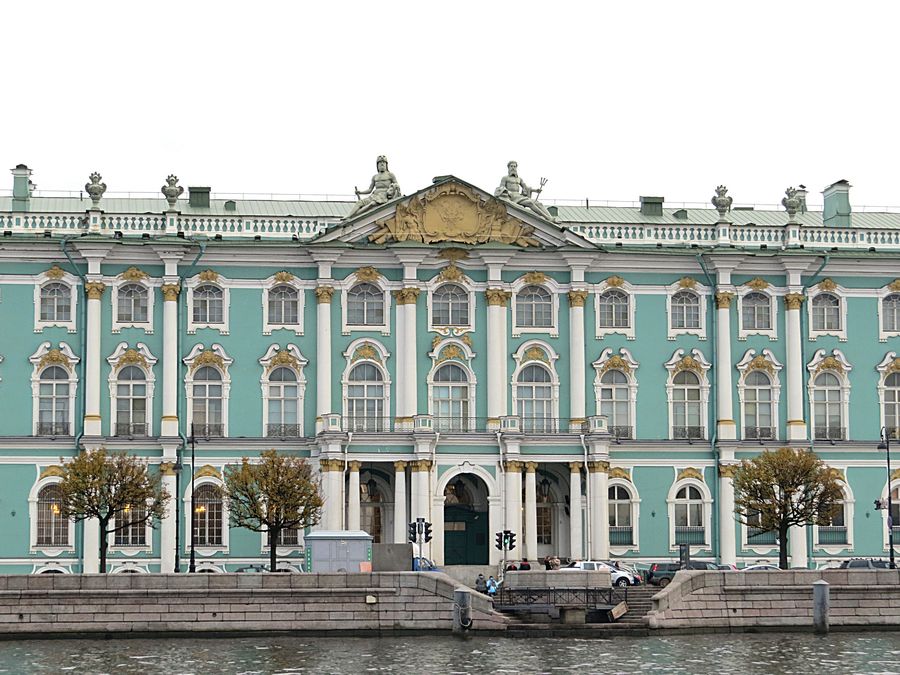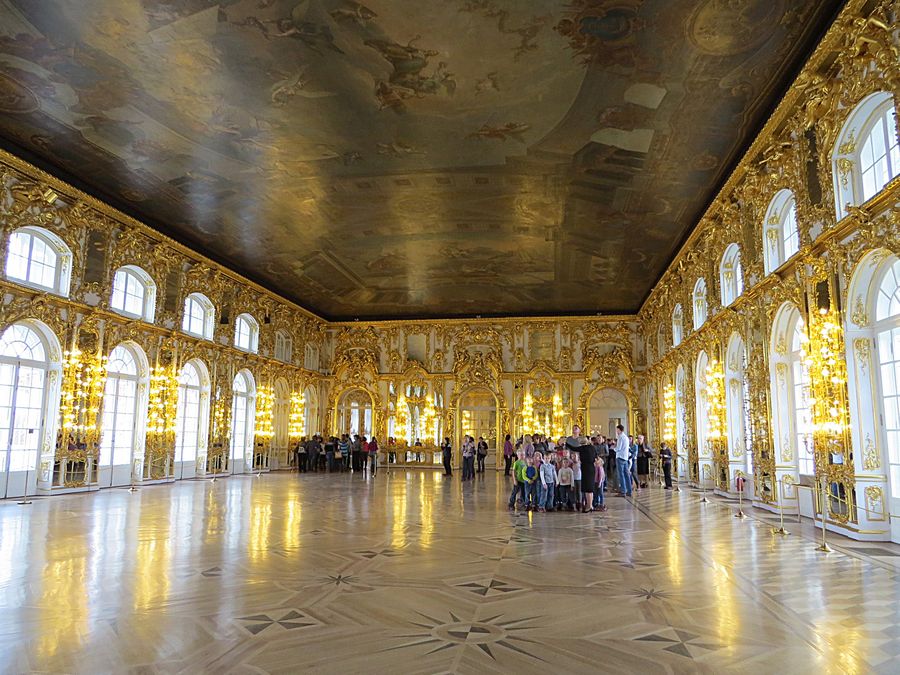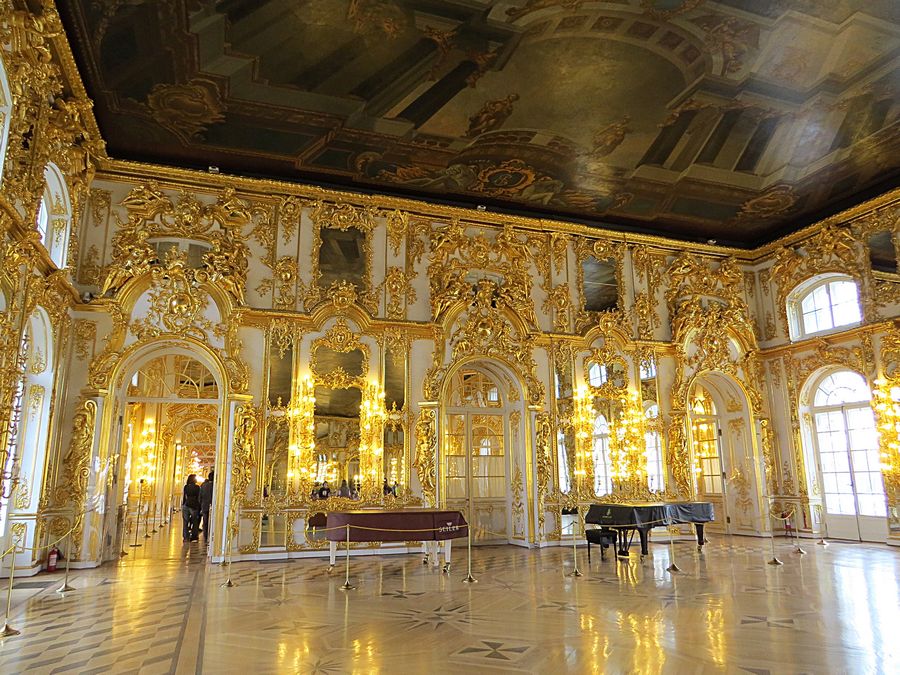The Baltic States, St. Petersburg, and Moscow
September 26 - October 14, 2013
Part Four - St. Petersburg, Russia
Russia now has an area of 6,591,027 square miles and a population of
over 141 million. It spans 2 continents, with the part west of the Urals
considered to be Europe, while the rest is considered to be Asia.
Like many parts of Eurasia, what is now Russia was overrun by Mongol
invaders that pillaged Russia for over 3 centuries. Ivan the Great eventually
defeated the Mongols and consolidated areas under Moscow's dominion
and took the title grand duke of all the Russias. In 1547, he was crowned
the first Czar of Russia. Peter the Great (1689-1725), after defeating Sweden
in the Great Northern War, founded a new capital, Saint Petersburg, and Russia
emerged as a major European power. Catherine the Great (1762-96) continued this
effort. In 1812, Napoleon invaded Russia but was forced to retreat after taking Moscow.
At the close of the Russian Revolution of 1917, a Marxist political faction called the
Bolsheviks seized power in Petrograd and Moscow under the leadership of Vladimir
Lenin. Civil war ensued, the Red Army triumphed, and the Soviet Union was formed in
1922. After Lenin's death, Joseph Stalin eventually gained power and eroded various
checks and balances that had been designed under the Soviet system. In the 1930s,
he launched the Great Purges, a massive series of political repressions. Millions
whom Stalin and local authorities suspected of being a threat to their power were
executed or exiled to Gulag labor camps in Siberia. The Red Army occupied Eastern
Europe after WWII, and Stalin installed loyal communist governments in these
satellite states. In the mid 1980s, reform-minded Mikhail Gorbachev came to power
and introduced policies of glasnost (openness) and perestroika (restructuring) to try
to modernize Soviet Communism. More conservative elements of the government
tried an unsuccessful military coup, which instead led to the collapse of the Soviet
Union. Boris Yeltsin came to power and declared the end of exclusive Communist
rule, and the Soviet Union splintered into 15 independent republics, and was
offically dissolved in December 1991. Vladimir Putin was elected to his third
term as President in 2012 (after a 4 year internal when Medvedev was President).
Putin's policies have raised concerns in the West about state control of the Russian
media through Kremlin friendly companies, government influence on elections, and
law enforcement abuses. There have been improvements in the standard of living
in Russia under Putin.
Page One - Arrival in St Petersburg and Catherine Palace

Ivangorod Fortress at the border between Estonia and Russia.
It is a Russian medieval castle established by Ivan III in 1492.
The fortress overlooks the Narva River opposite the Narva
Hermann Castle and the Estonian city of Narva.

Upon arrival in St Petersburg on a dreary afternoon, we took a canal and river
boat ride. St Petersburg is located on the Neva River at the head of the Gulf
of Finland on the Baltic Sea. In 1914 the name of the city was changed from
Saint Petersburg to Petrograd, in 1924 to Leningrad, and in 1991, back to
Saint Petersburg.

Part of the famous Hermitage Museum Complex from the Neva River
that runs through the City. During World War II, the City, then called
Leningrad, was besieged by German forces following its invasion in
June 1941. The siege lasted 872 days. The Siege of Leningrad was one
of the longest, most destructive, sieges of a major city in modern
history. It isolated the city from most supplies except those provided
through the Road of Life across Lake Ladoga. More than one million
civilians died, mainly from starvation. Many others were eventually
evacuated or escaped, so the city became largely depopulated.

Closer view of the Hermitage Museum.
The collection of the State Hermitage includes more than three million
works of art and artifacts of the world culture. Among them are paintings,
graphic works, sculptures and works of applied art, and archaeological finds.
The main architectural ensemble of the Hermitage consists of the Winter
Palace, the former state residence of the Russian emperors, the buildings
of the Small, Old (Great) and New Hermitages, the Hermitage Theatre,
and the Auxiliary House.

The golden dome of St. Isaac's Cathedral dominates the skyline. As you
can see, the Cathedral is under renovation.

The Catherine Palace is a palace located near St. Petersburg.
It was a summer residence of the Russian czars (also spelled tsars).
The residence originated in 1717 by Catherine I. The turquoise exterior
has rows of white columns with gold moldings.

School kids standing in the huge line inside the Palace waiting to start their
tour. They were more curious about me at this particular moment.

Ornate staircase. The interior rooms and halls of the Palace are spectacular
examples of the extravagant lifestyle of St. Petersburg's elite before the
Bolshevik Revolution.

The Great Hall that was used for receptions and balls. There are 2 tiers
of windows with mirrors placed between them. Light sparkles on the gilt.
The ceiling painting depicts Russian military victories and accomplishments
in the arts and sciences.


One of the many ornate rooms in Catherine Palace

Catherine II, Catherine the Great, portrait in the Palace.
Although the palace is popularly associated with Catherine the Great,
she actually regarded its architecture as old-fashioned. Many additions
and alterations were made between 1760 and 1790 under Catherine the Great.

Model of Catherine II with the style dress typically worn at that time.

When the German forces retreated after the siege of Leningrad during WWII,
they intentionally destroyed the Catherine Palace, leaving only the hollow shell
of the palace behind. Prior to World War II, the Russian archivists managed to
document a fair amount of the interior, which proved of great help in
reconstructing the palace. Although the largest part of the reconstruction
was completed by 2003, much work is still required to restore the palace
to its former glory. In order to attract funds, the palace's administration
has leased the Grand Hall for such high-profile events as Elton John's
concert for an elite audience in 2001 and an exclusive party in 2005 featuring
people such as Bill Clinton, Tina Turner, Whitney Houston, Naomi Campbell,
and Sting. You can see me taking this picture in the mirror.

View of the Palace from the extensive Garden. We did not spend much
time wandering around the Garden. This was the one day that we had rain
for an extended period of time. Of course, it was the only day that I did not
come prepared with my umbrella.

Sparkling above Catherine Palace at the northern end are the golden cupolas
of the Palace Church.
Link to Page Two - Hermitage Museum and Folk Show
Pat's Home Page